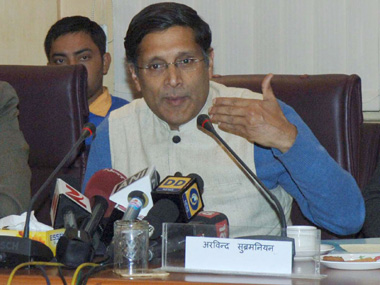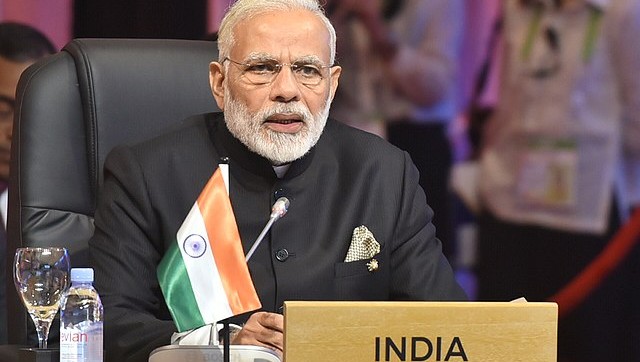Economic Surveys are dour documents prepared by stick-in-the-mud economists who fret about “risks”, “challenges” and “concerns” endlessly. At the end of the day, only economists get something out of them, and Finance Ministers usually ignore them.
Economic Survey 2014-15, produced under the supervision of Chief Economic Advisor Arvind Subramanian, is one of the few exceptions. It is a lucid document in plain English that offers a fairly optimistic assessment of India’s near and medium-term economic prospects, effectively mirroring Narendra Modi’s promise of “achche din”:
The Survey envisions the tantalising prospect of achieving “double-digit growth” – something the UPA could not ultimately achieve even with the most favourable global tailwinds during 2003-2008. The main thing needed to achieve double-digit growth, the Survey says, is a mix of “creative incrementalism”, and not necessarily “big bang” reforms. The accumulation of “creative incrementalism” in reforms (already visible in many actions of Modi’s government) will by itself add up to “big bang” reform.
This is an elevating message of hope for it does not seek to offer suggestions that will not fly in a political economy. It is a Survey which does not expect government to jump through hoops or perform extraordinary reform miracles to get the economy moving. In its overview of India’s prospects, it is realistic in saying that the centre should focus on the areas it can do something about, especially since the global context for India is favourable. “A political mandate for reform and a benign external environment have created a historic moment of opportunity to propel India onto a double-digit growth trajectory. Decisive shifts in policies controlled by the Centre combined with a persistent, encompassing, and creative incrementalism in other areas could cumulate to big bang reforms.”
In short, the Survey’s writers believe that steady, consistent efforts are good enough. We don’t need 1991-type big bang reforms today.
The reference to double-digit growth looks less daunting in the context of the new GDP measurement method announced last month by the Central Statistics Office (CSO). Using this method, GDP in 2013-14 was sharply revised upward to 6.9 percent (from 4.7 percent earlier), and advance estimates for 2014-15 project 7.4 percent growth. The Survey, which does not appear too eager to embrace the new GDP measurement process, nevertheless views it as a necessary evil since no other GDP number is now available for it. It says that using this new yardstick, GDP growth at market prices (the earlier one was based on factor cost) will touch 8.1-8.5 percent in 2015-16.
This is one reason why it believes that double-digit growth is just a hop, step and jump away for India with merely “creative incrementalism.”
However, the Survey does not base its optimism only on the new method of calculating GDP. So confident is it that India is becoming a great place to invest under a new government that it now recommends that we build a huge foreign exchange reserve to wield global economic clout. A large reserve adds up to geo-strategic muscle. Says the Survey: “If power used to flow from the barrel of a gun, in an increasingly inter-dependent economic world, hard and soft power derive from a war-chest of foreign exchange reserves. China’s abundant reserves have highlighted this fact. Reserves provide a cushion against shocks, creating economic and financial resilience. But they also create geo-political influence.”
So what is the Survey suggesting we do? Build our own $1 trillion war-chest (currently around $340 billion). It says: “The question for India, as a rising economic and political power, is whether it too should consider a substantial addition to its reserves, preferably its own reserves acquired though running cumulative current account surpluses, possibly targeting a level of US$ 750 billion US$-1 trillion over the long run.”
The economic pessimism of the last years of the UPA, it seems, is now a distant memory. But it is worth delving into what constitutes “creative incrementalism” according to the Survey’s authors – and what it wants fixed.
The Survey advocates action to tackle four problem areas principally. These are about “ramping up investment, rationalising subsidies, creating a competitive, predictable, and clean tax policy environment, and accelerating disinvestment.” Since the Modi government appears to be moving on all four fronts, it means that the right things are beginning to happen, even if final results are not yet visible.
The second reason why the Survey believes India’s economy is nearing the sweet spot of “nirvana” is favourable global developments coupled with positive domestic policy action. The expectation is that falling crude prices have (at least temporarily) ameliorated India’s twin deficits – both the external current account deficit, and the fiscal deficit, driven by the downward trend in subsidies. And inflation is looking less and less of a problem. Using the fall in global oil, the centre has cannily absorbed a part of the benefits in higher taxes to cut its fiscal deficit.
The economic slowdown has obviously bottomed out. Says the Survey: “In the short run, growth will receive a boost from lower oil prices, from likely monetary policy easing facilitated by lower inflation and lower inflationary expectations, and forecasts of a normal monsoon.”
Given below is a summary of the blessings and blips on India’s economic horizon, given largely in the words employed by the Survey’s authors.
Blessing - Good foreign inflows: “India ranks amongst the most attractive investment destinations, well above other countries. It ranks well above the mean for its investment grade category, and also above the mean for the investment category above it.” Thus, “the outlook is favourable for the current account and its financing…. Financial flows in 2014-15 are likely to be in excess of US$ 55 billion, leading to a sizeable accretion to reserves by about US$ 26 billion, to about US$ 340 billion. These inflows are likely to continue through a large part of 2015-16.”
Blip – An exchange rate challenge: “A likely surfeit, rather than scarcity, of foreign capital will complicate exchange rate management. Risks from a shift in US monetary policy and turmoil in the eurozone need to be watched but could remain within control. A key implication is that if the current account deficit is lower, a given level of capital inflows will create greater upward pressure on the rupee.”
Blessing – inflation is easing beyond expectations: “Structural shifts in the inflationary process are underway caused by lower oil prices and deceleration in agriculture prices and wages. These are simultaneously being reflected in dramatically improved household inflation expectations.” In fact, “the economy is likely to overperform on the RBI’s inflation target by about 0.5-1.0 percentage point, opening up the space for further monetary policy easing.”
Raghuram Rajan, are you listening?
Blip – the downside of lower food inflation is rural distress. Says the Survey: “A deeper shift in agriculture may be under way which calls for greater attention to this sector. The decade long shift in the terms of trade toward agriculture may have come to an end as global agricultural prices have peaked. As the terms of trade deteriorate and as rural incomes come under pressure, the political pressure for support will increase. Already, there have been proposals to raise tariffs in a number of sectors like oilseeds and pulses and to provide export subsidies in sugar.”
So what is the solution? “One response in the short run must be to enhance targeted support for the vulnerable in agriculture, namely the small farmer and agricultural labourer. The MGNREGA programme has the virtue of being reasonably well-targeted. The challenge here is to build on this feature and use the programme to build assets such as rural roads, micro-irrigation and water management, while also shoring up rural incomes.”
Modi said today (27 February) in Parliament that the NDA will not scuttle the MNREGA scheme, but improve it.
Blessing – The fiscal problem is easing: “The need for accelerated fiscal consolidation has lessened because macroeconomic pressures have significantly abated with the dramatic decline in inflation and turnaround in the current account deficit. Broadly speaking, the additional space opened up, including through a reduction in subsidies and higher disinvestment proceeds, should be occupied by public investment.”
The Survey believes that the Indian Raliways would have to be a major public vehicle for investment. “What the previous NDA government did for roads, the present government could do for the railways, strengthening the physical connectivity of the Indian population, with enormous benefits in terms of higher standards of living, greater opportunities, and increased potential for human fulfillment.”
Blip – the private sector can’t come to the aid of the party: “The balance-sheet syndrome with Indian characteristics (ie, excess debt on corporate balance-sheets) creates a web of difficult challenges that could hold back private investment. Private investment must remain the primary engine of long-run growth. But in the interim, to revive growth and to deepen physical connectivity, public investment, especially in the railways, will have an important role to play.”
Blessing – The Jan Dhan-Aadhaar-Mobile (JAM) combo will be a game-changer: The Survey says that the Pradhan Mantri Jan Dhan Yojana, when combined with the Aadhaar unique ID scheme and mobile payments technology, will be a game-changer – both for the delivery of support to the poor and for freeing subsidy-distorted markets. Says the Survey: “Today there are about 125.5 million Jan Dhan bank accounts, 757 million Aadhaar numbers, and approximately 904 million mobile phones. It is possible to envisage that when the JAM trinity becomes linked, the goal of periodic and seamless financial transfers to bank accounts after identification through the Aadhaar number can be implemented with immeasurable benefits… The heady prospect for the Indian economy is that, with strong investments in state capacity, that ‘nirvana’ today seems within reach. It will be a ‘nirvana’ for two reasons – the poor will be protected and provided for; and many prices in India will be liberated to perform their role of efficiently allocating resources and boosting long-run growth.”
Blip – It can’t all be achieved in one go: The Survey notes that currently only LPG subsidies are set to go entirely through the direct benefits transfer route. But the real challenge is the other subsidies beyond LPG. It says: “Rice, wheat, pulses, sugar, kerosene, LPG, naphtha, water, electricity, fertiliser, iron ore, railways – these are just a subset of the products and services that the government subsidises. The estimated direct fiscal costs of these (select) subsidies are about Rs 378,000 crore, or about 4.2 percent of GDP. This is roughly how much it would cost to raise the expenditure of every household to that of a household at the 35th percentile of the income distribution10 (which is well above the poverty line of 21.9 percent).”
Basically, what the Survey is hinting at is that if all subsidies were converted to cash, poverty can be eliminated completely. Shades of Modi’s claim that the goalpost must shift from poverty reduction to poverty elimination? That is the implied meaning of the government rising to the challenge of reforming the subsidy system.
Coming back to the idea of “creative incrementalism”, it is obvious that the Survey’s authors are effectively saying that the big reforms involve taking many small steps consistently.
The only big bang stuff it really advocates is legislating the goods and services tax (GST) – which is close to centre-state consensus and within grasp and reforming the public sector banking system.
The other pitch it makes is on Modi’s “Make in India”. This too must be achieved through “creative incrementalism” which calls for steady improvements in the ease of doing business (by reducing regulations and offering a stable tax regime). It specifically advises against any “big bang” protection for industry or trying to choose winners from among various sectors.
Instead it suggests a simple idea: reduce the negative protection given to many sectors.
Says the Survey: “The CVD, which is levied to offset the excise duty imposed on domestic producers, is not applied on a whole range of imports. These exemptions can be quantified. The effective rate of excise on domestically-produced non-oil goods is about 9 percent. The effective collection rate of CVDs should theoretically be the same but is in actual fact only about 6 percent. The difference not only represents the fiscal cost to the government of Rs 40,000 crore, it also represents the negative protection in favour of foreign produced goods over domestically produced goods.”
This is a great idea. Not only does it bring in more revenues, but it also levels the field for domestic manufacturers. What better way to promote Make in India without offending the WTO?
Arvind Subramanian deserves three cheers. This Economic Survey breaks the mould by taking the focus away from what is politically difficult to implement to what is achievable with persistence and consistent effort in smaller doses. It is politically a very sensible document – one not seen too often. One may add; it is in tune with what Narendra Modi’s approach to reforms and governance.
)
)
)
)
)